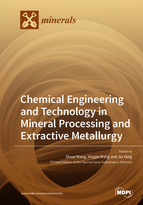Chemical Engineering and Technology in Mineral Processing and Extractive Metallurgy
A special issue of Minerals (ISSN 2075-163X). This special issue belongs to the section "Mineral Processing and Extractive Metallurgy".
Deadline for manuscript submissions: closed (30 April 2022) | Viewed by 68816
Special Issue Editors
Interests: fine chemicals; hydrometallurgy; flotation; nonferrous metals; manganese; heavy metal wastewater
Special Issues, Collections and Topics in MDPI journals
Interests: flotation; bioleaching; mineral resources utilization
Interests: resource utilization; extractive metallurgy; concentrate; separation and purification; sulphide mineral; matte; short process metallurgy
Special Issue Information
Dear Colleagues,
Chemical engineering and technology are the basis of mineral processing and extractive metallurgy. In the long history of human civilization, with the development of science and technology, chemical engineering, mineral processing, metallurgical engineering, and other process technologies coexisted and mutually promoted each other. More than 100 years ago, chemical engineers summarized the common laws in the process industry and built up the basic theory of unit operations. Today, the fluid flow, leaching, extraction, ion exchange and absorption, sedimentation, precipitation, evaporation, crystallization, distillation, electrolysis, and membrane separation are still typical operations in the process industry. It is undoubtedly of great significance to study the chemical engineering principles in mineral processing and extractive metallurgy to profoundly understand the essence of mineral separation and extraction, optimizing the technological flow of mineral processing and improving the utilization level of mineral resources.
The purpose of this Special Issue is to discuss chemical engineering principles in mineral processing and extractive metallurgy, with particular attention to the transport and chemical reaction processes, and the kinetics and thermodynamics of these processes. Of course, discussions on process intensification methods, such as mechanical reinforcement, ultrasonic, microwave, supercritical, and supergravity, are also welcome. The guest editors expect that a more in-depth discussion on chemical processes and principles can be performed in the Special Issue.
Thank you for your support.
Prof. Dr. Shuai Wang
Dr. Xingjie Wang
Dr. Jia Yang
Guest Editors
Manuscript Submission Information
Manuscripts should be submitted online at www.mdpi.com by registering and logging in to this website. Once you are registered, click here to go to the submission form. Manuscripts can be submitted until the deadline. All submissions that pass pre-check are peer-reviewed. Accepted papers will be published continuously in the journal (as soon as accepted) and will be listed together on the special issue website. Research articles, review articles as well as short communications are invited. For planned papers, a title and short abstract (about 100 words) can be sent to the Editorial Office for announcement on this website.
Submitted manuscripts should not have been published previously, nor be under consideration for publication elsewhere (except conference proceedings papers). All manuscripts are thoroughly refereed through a single-blind peer-review process. A guide for authors and other relevant information for submission of manuscripts is available on the Instructions for Authors page. Minerals is an international peer-reviewed open access monthly journal published by MDPI.
Please visit the Instructions for Authors page before submitting a manuscript. The Article Processing Charge (APC) for publication in this open access journal is 2400 CHF (Swiss Francs). Submitted papers should be well formatted and use good English. Authors may use MDPI's English editing service prior to publication or during author revisions.
Keywords
- hydrometallurgy
- flotation
- leaching
- extraction
- ion exchange
- adsorption
- electrolysis
- membrane separation
- unit operation
- transmission
- reaction
- kinetics
- thermodynamics








